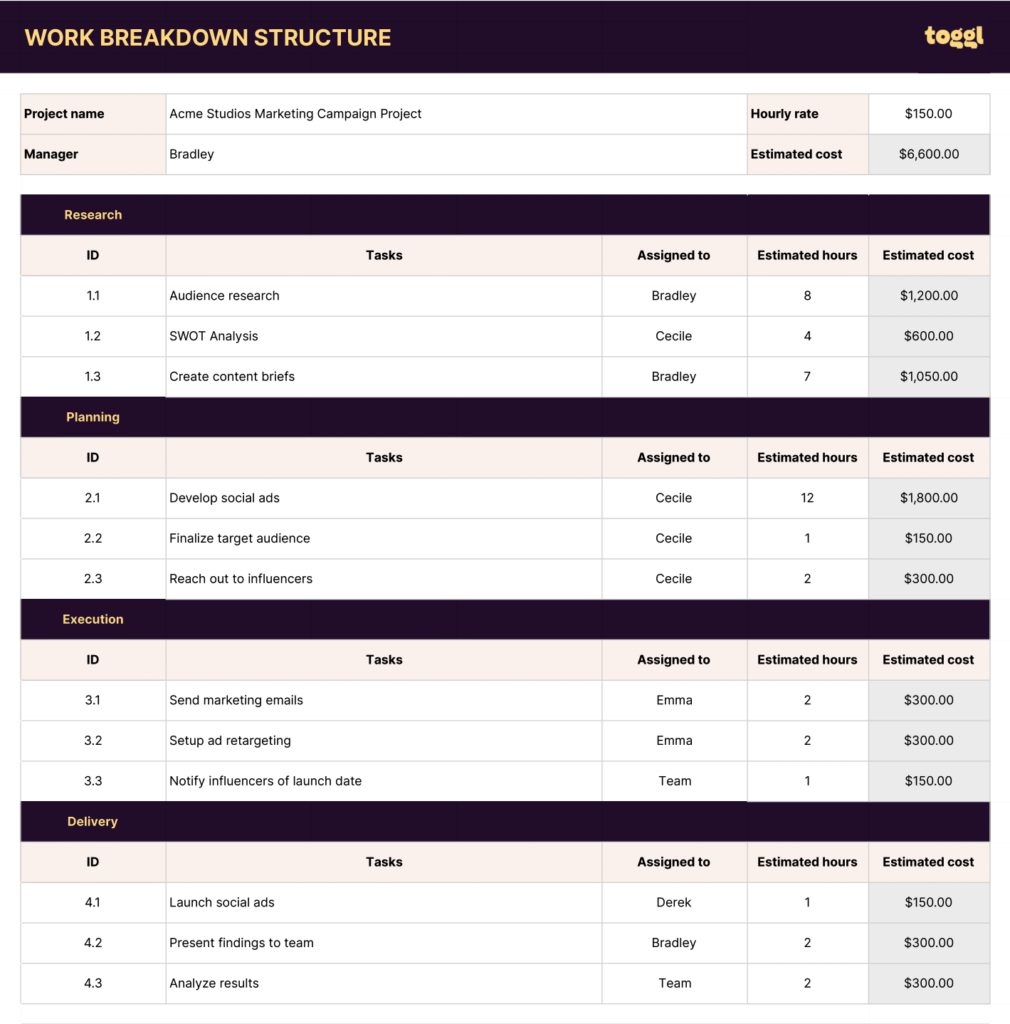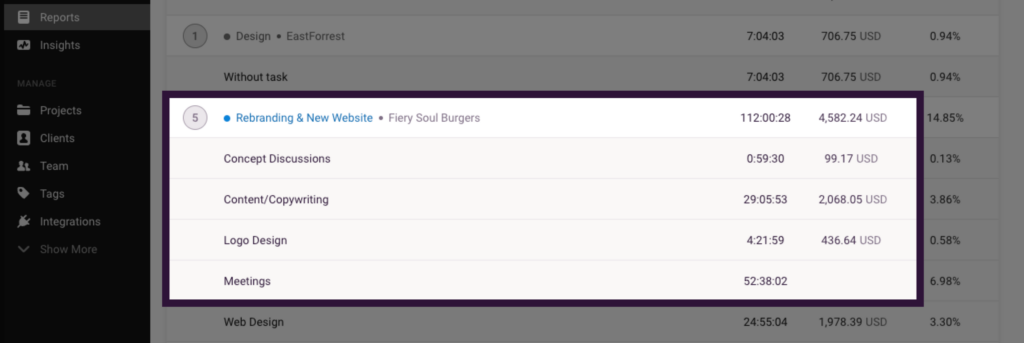Project estimation techniques are a project manager’s secret weapon — but accurately accounting for each is a massive challenge for project managers.
In this article, you’ll learn what project elements should be estimated, the different project estimating techniques available, and how you can start using estimation techniques to manage your next client project confidently.
What are project estimation techniques?
Project estimation techniques are methods to create project estimates. They help you accurately estimate a project’s cost, timeline, scope, resources, and risk. Helping you to get a solid understanding of what you’re working with, how long it will take, who needs to be involved, and what it will cost.
When your client or another project stakeholder asks you to estimate an aspect of the project, these techniques are what you need to use to give them the number they’re looking for.
Types of estimations to consider
Project estimation techniques can be applied to nearly every aspect of your project.
Here’s a quick summary of the ones you’re likely to use:
| Cost estimations | Calculating the total cost of the project to set the budget you need to complete it |
| Time estimations | Mapping out how long it takes to complete tasks and achieve milestones and creating a realistic deadline |
| Scope estimations | Determining the amount of work and number of deliverables needed to bring the project from start to finish |
| Resource estimations | Working out the people, software, tools, and other investments needed to get the job done |
| Risk estimations | Making space for what could go wrong |
Now let’s dive a little deeper…
Cost estimations
Estimating the cost of a project is one of the first (and most important) steps in project estimation. Cost is one of the three most significant constraints in project management, linked closely to time and scope.
But only 43% of companies mostly or always accomplish projects within budget, and 27% of all projects go over budget.
That’s due to many things — one being inaccurate project cost estimations.
Little consideration for details like both direct and indirect costs can really cost you.

Accurate cost estimation techniques are the difference between the Sydney Opera House costing $7 million and $102 million 🤯.
The type of cost estimate you create will depend on what stage in the intake process you are with the client.
Consider creating the following estimates for your next client project:
- Ballpark estimate
- Budget estimate
- Statement of work estimate
Want to learn when to create each type of estimate? Check out our ‘How to Estimate the Cost of a Project in 8 Steps‘ article.
Time estimations
Time will dictate the project timeline, set client and team expectations, and impact the project’s overall profitability.
Getting the necessary details to make accurate time estimations can be tedious.
You will need to consider what tasks you need to complete to estimate how long a project will take accurately.
This can be best done by filling out a Work Breakdown Structure and adding time estimates for each task.

Alternatively, you can grab a quick time estimate by looking at the Summary Report inside of Toggl Track. It will allow you to filter your project time entries by
- Team member
- Client
- Project
- Tasks
- Billable hours
Perfect for getting an overview of how much time was spent on past projects and their tasks.
Learning how to estimate time for a project is an excellent skill and will be the ace up your sleeve for every one of your future projects.
Maybe if they had a time tracking tool when building the Sydney Opera House, it wouldn’t have gone 10 years past the deadline 🤡.
Scope estimations
The scope of a project is the last of the big three estimations. Scope estimations help you predict all the work necessary to complete the project.
It’s best to scope out a project during a project discovery. This will help you to gather all project requirements so that you can create a more accurate project timeline and better estimate the budget needed.
Scope is a project constraint that can quickly spiderweb out and affect everything around it.
Some people think of these first three points (cost, time, scope) as the “project management triangle”, because if one side changes, the others have to.
The triangle on the left is a perfectly balanced project.
The one on the right?
Its scope got out of hand, so the project timeline got pushed back, and the project profits took a hit.
Taking the time to estimate these three big constraints will ensure your triangle stays nice and even.
Resource estimations
Team members, tools, and software carry your project to completion. It only makes sense to make sure you have the amount you need.
And yet only 26% of organizations say they always estimate their resources.
Your team is likely juggling multiple tasks and projects at a time— so accurately estimating resources ensures their availability and time are respected.
Resource estimation is the difference between team members so burnt out that they’re asleep at their desks and team members with nothing to do.
Risk estimations
“Nothing will go wrong.”
…is what we all wish we could say. But it’s a brilliant idea to plan ahead.
Project risks are simply problems that might not happen but could.
Software development in the cloud? Assume that there could be a server crash.
After identifying possible risks, go a step further into determining probability and project impact.
Factor in risks from the planning stage–don’t wait for them to show their ugly face when the client mentions them first. Or worse, when they suddenly strike.
Check out our guide, ‘How to Do Project Risk Management: A Manager’s Survival Guide‘ to learn more about project risks.
Project estimation techniques
There are a wealth of proven project estimation techniques, but here are the ones we think will be most helpful to you:
- Analogous estimation
- Top-down estimation
- Three-point estimation
- Bottom-up estimation
Analogous estimation
Analogous estimating is a simple way to gain an estimate of the cost of something. You look at similar projects you’ve completed before and use them as a reference for your estimations.
The issue with analogous estimates is that they tend to be slightly inaccurate.
They assume that:
- You have (accurate) historical data to reference
- There are no differences between projects
But this strategy saves time when there isn’t much information available or if you already have data from previous projects handy!
If you’re using Toggl Track, you can access the data of past projects within the Project Dashboard.

This will show you what time and costs went into each project.
Top-down estimating
Top-down estimating looks at the high-level project scope and budget, avoiding digging into the nitty-gritty of the work to create a ballpark estimate.
The client’s budget and timeline should be the source for the initial estimations. It is your job to take their numbers and divide them up so that you know how much money to spend on each task or phase of the project and how long they will take.
It is a form of analogous estimating, where existing knowledge of similar projects is used in the estimation process to produce a ballpark figure for the total cost.
But it’s a solid estimation technique if you have access to similar data from previous projects.
Again, you can do this by viewing Toggl Track’s Project Dashboard to get a quick overview of similar past projects to speed the process up.
The pros of the top-down method:
- Fast and cheap
- Requires little initial effort
- Pretty accurate if historical data is available
Cons include low accuracy if no historic data is present, and it’s also pretty easy to miss critical components and complexities with a top-down approach.
100% accuracy is not worth your time at the initial stages of client contact. Giving them a ballpark estimate is the best approach — unless you know they’re serious about working with you.
Completing a project for the first time? You will have to rely on your knowledge and experience of similar work. You can use historical averages once you’ve completed enough of a particular type of project.
Three-point estimating
Three-point estimating combines the best-case, worst-case, and most likely outcome scenarios to create an accurate, flexible estimate. This technique is useful when the client asks for a more detailed cost estimate.
There are two main ways to calculate it:
- Triangular distribution
- Beta distribution
The first treats every scenario equally likely, and the second puts more weight on the most likely scenario.
Triangular is best if you’re working with less data and want a quick calculation.
Beta is the best overall and the most accurate as long as you have enough data to ascertain the most likely outcome of your project.
When writing up the graphs, the triangular calculation is typically triangle shaped (who would’ve guessed?), and beta is more bell-shaped.
The triangular calculation can be done by taking the optimistic, pessimistic, and most likely outcomes, combining them, and dividing them by three.
Let’s say you estimate a project to take:
- 150 hours (optimistic)
- 250 hours (pessimistic)
- 165 hours (most likely)
Your triangular project estimate will be 188.33 hours.
Beta is more difficult, typically adding four times the weight to the more likely outcome versus the best and worst.
So using the data from the example above, you would end up with an estimate of 176.67 hours.
Check out this Three-Point Estimation Calculator if you want to play around with the numbers.
However, that calculator is useless if you don’t know what numbers to plug in.
Use Toggl Track to view past project data on the Project Dashboard to get a quick overview of how long similar projects have taken.
- Optimistic outcome – look at the length of time for projects that went exactly to plan
- Pessimistic outcome – look at the length of time for projects that didn’t go to plan.
- Most likely outcome – look at the length of time for projects that mainly went to plan

Pros of the three-point technique include the following:
- High accuracy
- A hearty dose of realism
The main con to three-point estimating is the effort required to do it, as it’s a pretty labor-intensive process properly.
So when is it best to use it?
When you’ve completed one (or preferably more) projects using time tracking software, that way, you have a wealth of data to measure your new project against, so you’re not starting from scratch every time.
Bottom-up estimating
The most accurate project estimation technique of them all.
Bottom-up estimating considers the time, cost, and effort for each task within the project. It then adds it up to create an estimation for the entire project.
This means it can be a super accurate estimation technique if you have completed a thorough Work Breakdown Structure (WBS) for the project and have access to historical data.
How does a WBS work?
It helps you break down a project into its tasks, which are then estimated separately and added to calculate the total project cost.

Once you’ve filled out a WBS, you can use Toggl Track to triple-check your estimations. Use the Reports Dashboard and head to the Summary Report to filter by project and then view individual tasks for each project.

You can also track individual project tasks using Toggl Track. Doing so will give you access to the data you need to create a solid bottom-up estimate.
Pros of bottom-up estimating:
- Calculating from a micro-level boosts accuracy enormously
- Reduces risk due to taking in the small details
- Flexible for a variety of tasks (different tasks take different amounts of time and resources)
What are the cons of bottom-up estimating? Calculating can be time-consuming and slow-moving without the right tools.
Who estimates projects?
This will depend on the size of your business. Generally speaking, the project lead is responsible for estimating the different aspects of each project. But it is up to the whole project team and any experts to help create and refine the project estimates. The more people know about it, the more realistic the estimations will be.
But this will depend on what type of estimation you’re doing. Is it a quick ballpark estimate? That’s the responsibility of the project manager. Working on a budget or statement of work estimate? Get the team involved.
We recommend checking out our project cost estimation guide to learn more.
When should estimates take place?
The project estimation process will depend on your project intake process and how detailed you get with your initial project estimate.
But you should avoid creating detailed estimates (bottom-up) during the initial stages of the project — primarily if you haven’t gathered all project requirements.
Follow a simple process of defining the overall project budget and creating different types of estimates before you sign off on a statement of work.
These include:
- Ballpark estimate
- Budget estimate
- statement of work estimate
Again, it’s worth checking out our project cost estimation guide to learn more about the different types of estimates you can create.
It’s also worth pointing out that your estimation process will depend on your project management approach.
For example, Agile projects take a flexible approach to planning. Most Agile frameworks divide projects into smaller tasks or iterations. In this case, estimates would be done at the beginning and then again during each phase/sprint.
With Waterfall project management, the planning phase comes right has been initiated. This is when baseline estimates will be created and logged.
Next steps
Accurate project estimation is the make or break of your entire project’s outcome.
Bottom-up, top-down, three-point – there’s no right answer. There are different estimation methods for a reason, so consider the purpose of your estimation and pick the one that’s right for you.
Are you looking to continue improving your project management game?
Check out the following articles:
- How to Estimate the Cost of a Project in 8 Steps
- How to Create and Manage a Project Budget
- Work Breakdown Structure Guide
Sean is a Content Marketer at Toggl. He's been involved in SEO and Content Marketing since 2017. Before working for Toggl, Sean ran SEO at a digital marketing agency—so he's all too familiar with time tracking and project management.



